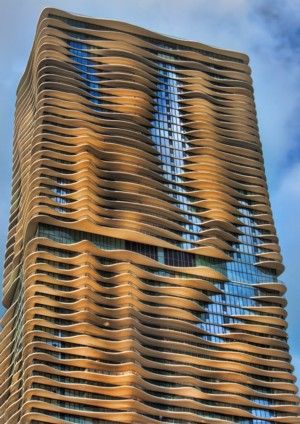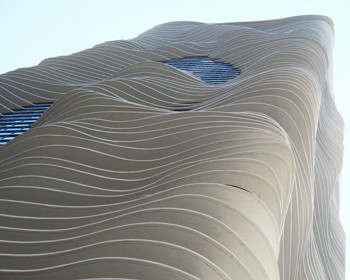While rootling around in my personal blog archives chasing up something else, I recently found myself looking again at this 2007 posting, about what looked like being a really cool tower, in Chicago. So, I wondered, did they actually build it?
Indeed they did. Here is a good photo culled from amongst these, which I found here:

I also particularly recommend these photos, which say “^John Picken- flickr/cc license” in among them, so I’m guessing that means don’t copy without asking, so I didn’t. But that needn’t stop you looking at the photos where I found them.
LATER: Wrong. “cc” means (see comments) creative commons. (I thought it meant copyright only more so.) So here’s another picture:

It’s called the Aqua Tower. Likes and dislikes in architecture are very much a personal matter. One man’s masterpiece is another’s mediocrity or worse. But I liked the idea of the Aqua Tower when I encountered it five years ago, and judging by the photos I’ve seen, I would like the reality of it now, if I were to see it in the flesh.
It is truly remarkable how similar the photos of this building are to the imaginary pictures of it when it was first announced, which is not always how it is, to put it mildly.
Says this:
Aqua certainly succeeds in making a strong visual statement, but what makes the statement noteworthy … is the simplicity and economy of the main vehicle of expression: the curvy and varied projection of the buildings concrete floor slabs. Aqua does not rely on expensive cladding materials or subject its occupants to impractical interior spaces for the honor of architectural aesthetic.
The floor slabs are a necessary part of the 82-story building’s structure and Studio Gang manipulated them to simultaneously enhance sightlines of major Chicago sites from the balconies (increases function) and give the building exterior an innovative form (increases beauty). The glass-skinned walls of the condo and hotel units behind the balcony edges are rectangular and therefore economical and functional.
Which is a more detailed version of what I said in 2007:
What I admire about this building is that, under the cute decoration, it is a bog standard, structurally and economically completely logical tower.
I also learned, here, that the Aqua Tower is the tallest building in the world designed by a woman. Her name is Jeanne Gang. Meanwhile, the men have not stopped trying to outdo each other. You suspect that with that building, we are back with “impractical interior spaces for the honor of architectural aesthetic”. And speaking of impractical interior spaces, at any rate towards the top, here in London, the Shard is nearly done, and is looking very good, or so I think.
I entirely realise that this latest phase in the history of architecture has been fuelled by silly money. But when you consider what else this money has also been spent on, I say thank heavens we at least have some good looking stuff to show for all the agony.




“cc licence” refers to the Creative Commons license, which is usually used as a method of legally embedding the right to copy a work freely. There can be some caveats, but 99.9% of the time you see someone using a CC license, it’s okay to copy and modify it however you like as long as you don’t try to sell the results.
The first photo on the linked article is at
http://www.flickr.com/photos/picken/3560424978/in/set-72157626685168404
which indicates that it is Attribution 2.0 Generic (CC BY 2.0) licensed.
The rest of the photoset at http://www.flickr.com/photos/picken/sets/72157626685168404/ I’ve not checked
My first thought was “cpu cooler”, my second was “where are the Aliens”. I’d go to see it though, it looks interesting and seems like one of those things that need to be directly experienced before forming to a judgement.
That’s what impresses me most about it: behind the wibbly balconies, it’s actually just a rather ordinary glass brick, yet the effect is of something quite outlandish. It reminds me faintly of Gaudi.
You’re several hundred miles closer to the Shard than I am, Brian, but I get the impression that it’s another building that looks unusually similar to the pre-construction CGI renderings. I’m not sure whether it’s the CGI that’s getting better or the buildings that are getting weirder. Probably both.
It is not hard to de-cruft links.
This
http://nextbigfuture.com/2012/06/tallest-building-in-world-sky-city-to.html
works just as well as this
http://nextbigfuture.com/2012/06/tallest-building-in-world-sky-city-to.html?utm_source=feedburner&utm_medium=feed&utm_campaign=Feed%3A+blogspot%2Fadvancednano+%28nextbigfuture%29
I like it, too. But I often think it wise to remember Sir John Summerson’s warning that you can never really judge a building’s architectural merit until it has stood for a hundred years.
Recently, I’ve found myself admiring both the South Bank centre and that huge block of flats (recently abandoned) opposite Elephant & Castle train station. I’d never have imagined either of those things could happen!
Stephen Willmer
You have a point. Could this thing look like a lava lamp in twenty years time?
Perhaps it will depend on what else gets built in the meantime.
Ah, Gaudi, he of the Corncob Cathedral. Sometimes ‘different’ is not ‘better’.
Brian, I tend to find that buildings go through phases, at least in my appreciation of them. In particular, the period from 20 to 40 years after they were built, is a dangerous one – and not just in my estimation – because that’s when buildings start to look a little shop-worn and unloved. I can’t help but wonder whether demolition of much brutalist architecture will come to be seen as on a par with the mid-Victorian demolition of a number of the City churches, although my preference is of course always for the owners of buildings to do with them what they want.
And talking of the built environment, I love the way in which London seems to be becoming a city of glass. And there is an extraordinary band of stunning new architecture on an axis out of Waterloo, hugging the river and a little inland, down to New Cross.
But how long will glass last?
SW
On the subject of glass buildings not lasting, have you looked recently at the new London Parliament building? The one colloquially known as “the Testicle”, for obvious reasons. Basically a big spheroid object.
That is now looking decidedly the worse for wear. I think I have a photo of that somewhere, looking very tatty. I’ll try to dig it out.
look: http://benvanderveen.files.wordpress.com/2011/08/milehigh.jpg
Stephen: As someone who went to a predominantly brutalist university, I just want to say two things:
1) It is possibly the most appropriately designed movement in the history of any art form.
2) More people will miss smallpox than will miss poured-concrete monstrosities.
Brian, no I haven’t seen the testicle up close for a while. Interesting, what you say.
Alsadius, would you say all brutalism is equally bad?